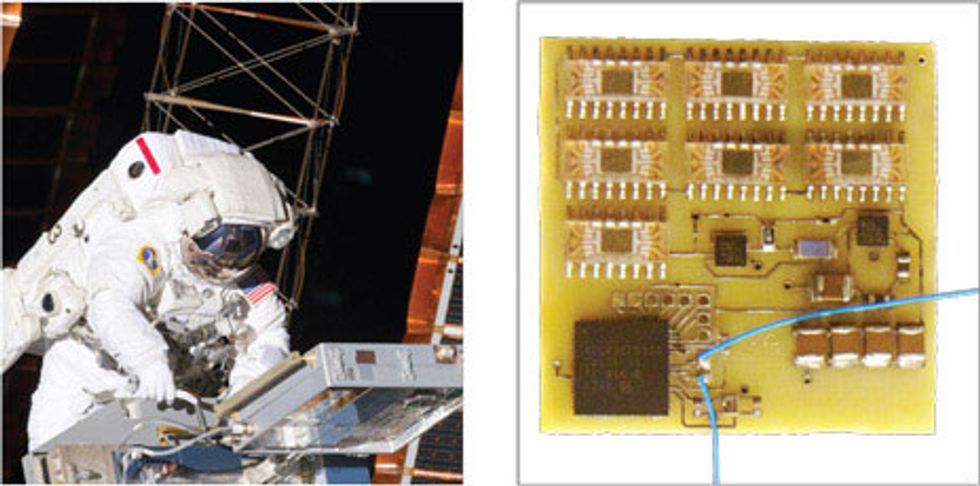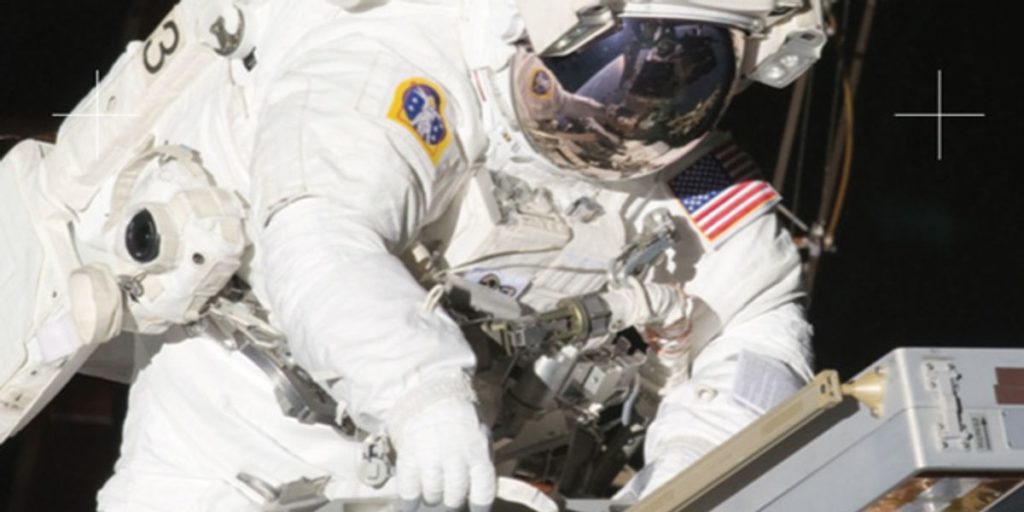
In Flight: NASA astronaut Andrew Feustel installs a materials science experiment pallet on the outsideof the International Space Station. The box includes three prototypes of integrated circuit spacecraft. The spacecraft prototype at right was photographed before installation on the space station.
Photos: left, NASA; right, Zac Manchester
Gravity may be woven into the very fabric of space-time, but some objects seem nearly immune to its pull.
Scale something down to the size of a dust particle and you’ll find it can stay aloft almost indefinitely, dancing in midair on thermal currents. With matter that size, the force of air striking the surface of the particle outmatches gravity’s effect on its tiny mass.
This behavior is more than just a curiosity: It could have profound implications for space exploration. Spacecraft have been getting bigger and bigger for decades, ballooning in size to carry ever more impressive equipment, from the Herschel Space Observatory‘s 3.5-meter telescope to the Cassini probe’s 11-meter magnetometer boom. But if we can reverse that trend and instead build the tiniest spacecraft possible, we can create entirely new ways to study the solar system and beyond.
Miniaturization will inevitably mean limitation—less power, fewer instruments, and reduced ability to store and broadcast data. But dust-mote-size spacecraft could do things that no current space probe can do: coast without a parachute onto the plains of Mars or float for weeks in the soupy atmosphere of Titan. They could be mass-produced and launched by the thousands to form vast space-based networks of sensors. And if the probes could be made thin and lightweight enough, alternative forms of propulsion could eventually send them to distant worlds, without the need for rocket fuel.
In the fall of 2005 at Cornell University, graduate student Justin Atchison and I set out to create such miniature spacecraft. The aim of our project, called Sprite, is to fit everything a satellite might need on a 1-square-centimeter integrated circuit. The project finally took its first step into space on 16 May of this year, when the space shuttle Endeavour, on its final mission, carried three of our prototypes to the International Space Station. We’ll find out in a couple of years how these first chips withstood the rigors of space. If all goes well, we then plan to launch smaller Sprites into orbit on their own, where they can be used to test new forms of propulsion that could ultimately take them to other planets.
Sprite is the first spacecraft-on-a-chip project to launch a prototype, but ours isn’t the only group exploring the potential of miniature spacecraft. The idea goes back at least 15 years, and it has its origins in “smart dust”—tiny microelectromechanical sensor systems that can be used to measure light and temperature, register movement and location, and detect chemical and biological substances. The notion of sending such systems into space was slow to gain momentum. But it began to take off once space researchers realized that integrated circuits had become quite inexpensive, dense, and easy to fabricate, and that almost everything a spacecraft needs can now be made with semiconductors alone: solar cells for power, capacitors for energy storage, and all the memory and processing capability you could want. As with smart dust, a diversity of payloads can be fabricated to ride on a chip, including basic spectrometers, load sensors to measure particle impacts, chemical sensors, and simple CMOS cameras. Researchers around the world, including groups at Surrey Space Centre, the University of Strathclyde, the Aerospace Corp., and the Jet Propulsion Laboratory, have explored the possibility of making chip-based spacecraft and are investigating their capabilities.
Our Sprite prototypes weigh about 10 grams, but their successors will ultimately weigh between 5 and 50 milligrams and will likely be able to carry just one simple sensor each. At that size, a single Sprite will never be able to rival the data-gathering capability of such precision instruments as the Hubble Space Telescope. But we envision launching these tiny, easy-to-fabricate chips en masse to form something new: distributed sensor networks.
We could, for instance, send tens of thousands of Sprites into orbits between Earth and the sun. These simple chips would have one task: to send a signal to Earth when the local magnetic field or the number of charged particles that hit the spacecraft exceeded some threshold. Taken alone, each chip would provide just one data point. But a network of these scattered chips could produce 3-D snapshots of space weather, something no traditional spacecraft, no matter how sophisticated, could ever do on its own. A payload of a million of the relatively heavy 50-mg version of the Sprite would amount to just 50 kilograms, about the mass of a single science instrument on one of NASA’s larger interplanetary spacecraft. So the launch costs of a Sprite network would be significantly lower than that of a traditional satellite.


